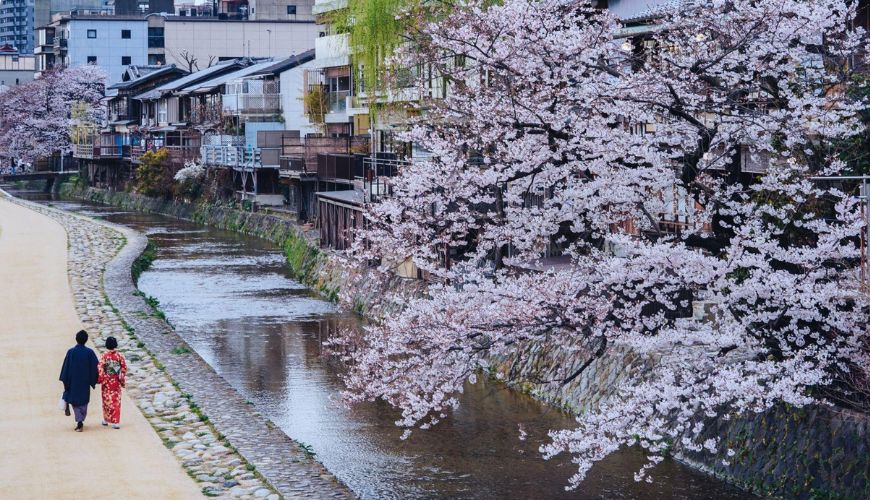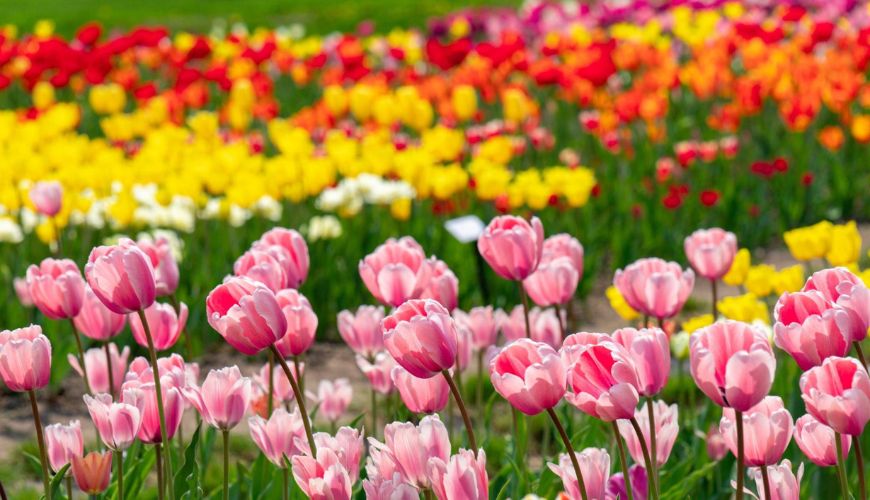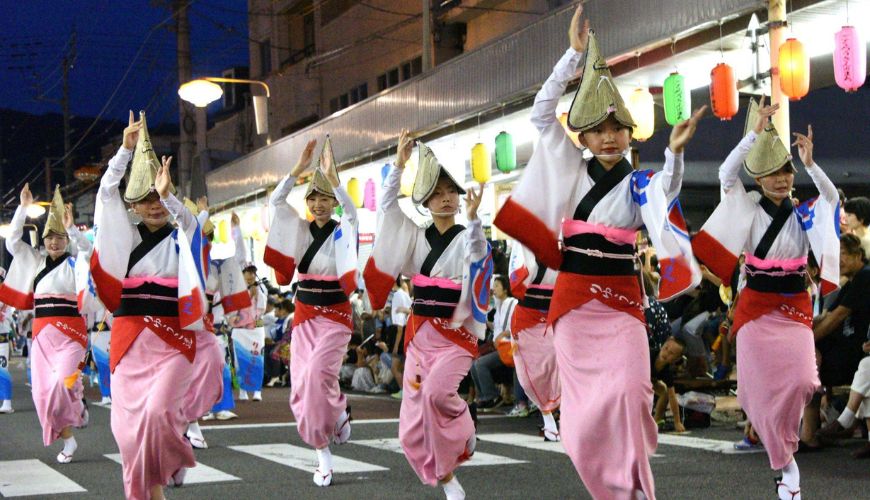Call Us: +1 315 998 1998
Because of its position between mainland Asia and the Pacific, Japan experiences four different seasons and a wide range of climates. As someone who has spent time in Japan, I can attest that the Japanese are justifiably proud of their seasons. From a picnic among the cherry blossoms in the spring to a wintertime dip in an onsen amidst the snow, they relish each changing of the seasons.
rnSummers are warm and bright, while winters are cold and snowy; each season offers unique opportunities. When to visit Japan might be challenging, but I've listed the best and most underrated activities for each season below. Check out our Japan travel guide for additional information on scheduling your trip to coincide with Japan's seasonal transitions.
rn Springtime in Kyoto, Japan's Philosopher's Walk.
Springtime in Kyoto, Japan's Philosopher's Walk.
Ancient Japanese poetry celebrates the appearance of cherry blossoms because of their significance to Japanese culture over many centuries. Under the canopy of the flowering trees, the nobility, poets, artists, and courtesans would celebrate the arrival of spring.
rnPicnicking beneath the cherry blossoms, or hanami ('hana' meaning flower and'mi' to see), has become a national tradition in Japan.
rnThe beauty of these flowers lies in their short lifespan—anywhere from two weeks to two days (a little rain may wash away the delicate petals). In the south, Okinawa sees the first blossoms in early February, and by the end of May, the northern island of Hokkaido has also bloomed.
rnThe best time to see Tokyo, Kyoto, and the rest of the main island in bloom varies yearly, but it's usually around the middle of April. Hundreds of cherry trees line the 2 kilometers (1.2 miles) long Philosopher's Path, a stone walkway in Kyoto's Higashiyama neighborhood. Nearly 1,200 trees bloom with clouds of pink in Tokyo's Ueno Park, providing fluffy parasols for the crowds of people having picnics in the shade.
rnHotel accommodations in Japan may be booked up to a year in advance during the cherry blossom season. If you want to get away from the crowd, you may get on a plane and go two hours north of Tokyo to the charming castle town of Hirosaki. Around Hirosaki Castle, which is around three stories tall, 2,600 cherry trees are said to bloom in April.
rnKakunodate, a Samurai hamlet in the Semboku area, is renowned for its beautiful juxtaposition of fluffy pink petals and stern black walls. It is another well-known location less likely to have a tourist influx.
rnSpring has more to offer than just cherry blossoms. The plum blossom, whose tiny, bright-pink petals are sometimes mistaken for cherries, opens its petals between the middle of February and the middle of March. Fields of tulips and phlox in every rainbow color may be seen in Hokkaido.
rnIn late April and early May, you may visit the Kameido Tenjin Shrine in east Tokyo and stroll amid tunnels of blooming mauve wisteria.
rnMany Japan’s gardens shed their winter coverings in the spring, allowing the bright green foliage and blossoms to emerge.
rn Hokkaido tulip gardens
Hokkaido tulip gardens
From taiyaki (stuffed fish-shaped cakes) to mochi (sweet rice balls) to beer created from the petals, the variety of cherry blossom-themed cuisine is almost ludicrous. In the spring, people may be seen picnicking in parks while eating bento boxes, often including seasonal ingredients like bamboo shoots and lotus roots. These elegantly packed lunches may be purchased at your neighborhood convenience shop, often including sushi, prawn tempura, and grilled salmon.
rnRice cooked with clam fluids and garnished with fresh mitsuba (Japanese parsley) is a seasonal staple at this time of year. The steamed clams in sake are a heavy meal.
rnTwenty minutes by rail from Kyoto, in the economic hub of Osaka, begins one of Japan's six yearly Grand Sumo Tournaments. I like watching sumo because the rules are straightforward and the sport is simple to understand. Each fight ends when the loser is forced out of the ring or is the first to touch the floor with any part of his body other than his bare foot. Massive stomping happens before each round as the wrestlers try to out-psych each other.
rnOne of the world's major animation conventions, AnimeJapan, occurs in late March. Hundreds of stores, seminars, and workshops relating to anime gather at Tokyo's Big Sight convention center for this annual event. The cosplay section, where attendees display their (often highly intricate) handmade costumes, is a highlight.
rnThe Japanese are notoriously lousy at planning vacations, so the government instituted a mandatory weeklong holiday called Golden Week at the end of April. Too many people at the sights and hotels become booked early, so I wouldn't recommend traveling then.
rn Awa Odori, Tokushima
Awa Odori, Tokushima
Even if summer in Japan doesn't offer its spectacular counterpoint to spring's bloom, it does mark the beginning of the festival season, when fireworks light up the sky almost every night. There are also fewer tourists, which means cheaper hotel rates.
rnBeginning in June, the air gets stickier, and temperatures rise progressively during July and August. Almost every building has air conditioning, so you can easily cool down. Still, the typical temperature is approximately 32 °C (90 °F), so you should take it easy the first few days until you adjust to the heat.
rnThe Shiretoko Peninsula in Hokkaido is seldom visited, although it is one of the best sites to see Japan's untamed, undeveloped landscapes and fauna. Hiking through large swaths of well-conserved wilderness, cruising to observe wild bears fishing for salmon on the beach, and searching for beaked whales in the nutrient-rich seas are possible ways to spend time here. The weather is more pleasant for outdoor activities since it is colder than farther south.
rnIf you're a birdwatcher, make the trip up here solely to see a red-crowned crane, a rapidly declining species (though you'll have to suffer the winter to see the outrageously spectacular mating rituals).
rnHokkaido is also a prime location for studying the Ainu, the native people of Japan's northern islands. The Upopoy National Ainu Museum and Park is an outdoor Shiraoi museum where you can see traditional Ainu dance and music performances.
rnRefreshing flavors are the focus of summertime fare. Hiyashi Chuka (cold ramen) is the staple food of Japan. It consists of cold noodles and seasonal veggies mixed in a vinegary sauce. Whether or not a hiyashi chuka is delicious depends on how many different flavors and textures it incorporates, from the cool crunch of cucumber to the sweetness of peach.
rnShaved ice drenched in syrup is known as kakigori in Japan and is a popular summertime dessert. You may keep it plain and basic by purchasing a cup from one of the vendors hawking brightly colored fruit syrups in neon containers. You may get an artisanal version with toppings like soybean paste, matcha tea, and pumpkin cream at a specialty store in a major city.
rn Matcha Kakigori, Tokyo, Japan
Matcha Kakigori, Tokyo, Japan
Japan seldom has a summer evening without fireworks; summer is a festival and celebration season. And I don't mean just a few loud explosions here and there. I have yet to see better fireworks than those created in Japan (many of the exhibits during the Olympics were constructed there).
rnDuring the first week of August, Buddhists worldwide commemorate their ancestors' life with fireworks and dance. This festival is known as Obon. Tokushima on Shikoku Island hosts the Awa Odori dance festival, which draws visitors from around Japan.
rnAbout 450 years ago, Tokushima's daimy (feudal lord) gave out sake as a prize to the locals after a successful rice harvest. The streets erupted in dancing, a tradition that has continued annually since.
rnWhile residing in a neighboring town, I danced in the event. It's grown into a big, multi-day street festival. Women wore traditional hats called amigasa, which looked like two fans glued together, and geta (uncomfortable-looking wooden shoes), and we danced in a parade around the city to synchronized steps.
rnIn the evenings, everyone puts on their light cotton yukata kimonos and heads down to the riverfront to watch the fireworks while snacking on kakigori.
rnClimbing Mount Fuji, only possible during July and August, may be highly romanticized in your guidebook. There are better ways to spend your time. You can only wait in line to reach the peak when the mountain fills up. The best view is from a distance, from the coast of one of the five lakes in the area.
rnJune is when the rainy season in Japan usually begins to strike the mainland. Temperatures average approximately 25°C (77°F), and humidity levels exceed 80%.
rn Kurobe Gorge
Kurobe Gorge
The native momiji maple tree's leaves turn a brilliant crimson and orange in the fall, creating a blanket of color over the countryside (known as koyo) that begins in Hokkaido in late September and spreads to
Start thinking about your experience. These itineraries are simply suggestions for how you could enjoy some of the same experiences as our specialists. They’re just for inspiration, because your trip will be created around your particular tastes. Start thinking about your experience. These itineraries are simply suggestions for how you could enjoy some of the same experiences as our specialists. They’re just for inspiration, because your trip will be created around your particular tastes.Start planning your trip to Japan
Tell us about your plans and one of our specialists will plan a unique trip for you…
Can’t get any ideas for you next trip? Let TripAdvisor help you!
Find something else special